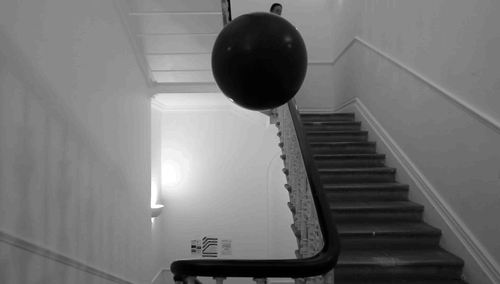A floating orb that records its surroundings. A Steve Reich/Pac-Man mashup. A first-person-hacker Oculus Rift game. A wearable device that produces sounds from a dancer’s movements. A tank “driven” by a goldfish.
Welcome to the world of Prosthetic Knowledge, an influential art-tech Tumblr that features a fascinating and relentless stream of creative projects and experiments from around the world. Anybody with a taste for cutting-edge tech and experimentation has probably encountered the Tumblr—even if only indirectly.
Every Prosthetic Knowledge post gets hundreds of likes and reblogs, and many get picked up by the mainstream tech press and beyond. Several of the stories about bizarre, experimental technologies that you read online will have originated with blog posts on Prosthetic Knowledge.
 The floating orb that records its surroundings, as seen on Prosthetic Knowledge.
The floating orb that records its surroundings, as seen on Prosthetic Knowledge.
So who is behind this thing? The answer turns out to be Rich Oglesby, a friendly 37-year-old Brit in Oxfordshire, England, who oddly enough has never been interviewed before now. Oglesby explained to me the origins of Prosthetic Knowledge in a simple phrase: “Blogging therapy.”
And, as it turns out, I reached him at a moment when he’s flirting with trying to convert his therapeutic hobby into something bigger.
Every Prosthetic Knowledge post gets hundreds of likes and reblogs, and many get picked up by the mainstream tech press and beyond. Several of the stories about bizarre, experimental technologies that you read online will have originated with blog posts on Prosthetic Knowledge.
A post on Oculus Rift-enabled gender-swap experiment The Machine To Be Another, for instance, was way ahead of web observers such as, um, me. Prosthetic Knowledge citations pop up everywhere from The Verge to Kottke to Laughing Squid. One post even inspired fan fiction (about a branch burning on power lines).
Part of the appeal is the unique way the site presents its finds: straightforward text, often directly quoted from the maker of whatever project is being highlighted, usually combined with a handful of purpose-built GIFs that make even the most baroque experiments seem irresistible.
So who is behind this thing? The answer turns out to be Rich Oglesby, a friendly 37-year-old Brit in Oxfordshire, England, who oddly enough has never been interviewed before now. Oglesby explained to me the origins of Prosthetic Knowledge in a simple phrase: “Blogging therapy.”
And, as it turns out, I reached him at a moment when he’s flirting with trying to convert his therapeutic hobby into something bigger.
Oglesby says he did a couple of years of computer studies back in school, and then, because of his interest in the graphic and artistic possibilities of technology, spent a couple of years studying art. “Biggest career mistake I ever made,” he says with a laugh. He never finished that art degree and ended up working in Internet research for a variety of employers—“basically a data-serf,” as he describes it.
Along the way he’d developed a reputation among friends and colleagues as a guy with a remarkable knack for finding interesting stuff on the Internet. Blogging didn’t really interest him until he discovered Tumblr, with its visual-heavy presentation and emphasis on ease of use. (Disclosed: Yahoo now owns Tumblr.)
His unusual GIF-centric style came about because long videos don’t really spread on Tumblr, no matter how interesting the project they document. This also eliminated the need to write much: “The artifact speaks for itself.”
Oglesby declined to get specific about his follower count, but his influence and popularity have obviously grown over time. The Internet-arts organization Rhizome recently tapped him to contribute to its site. And nowadays creators seek him out—a recent post about an insane project called Space Replay, involving “a floating sphere that records and replays the sounds from its surroundings,” came as a result of contact from the makers.
Oglesby goes out of his way to assure me, “I don’t consider myself an artist in any way,” but he’s also taken to making digital artifacts of his own. “Lenticular Encryption: Putin” mashes together images of “a powerful figure who has presented his many sides through technology, with different technologies (language, racing cars, pianos, horses), presented as one.” It appears on the mobile-device-oriented Widget Art Gallery.
But I suspect Oglesby is a curator at heart, with that unique combination of voracious curiosity, distinct taste, and heartfelt enthusiasm. As it happens, he quit his most recent data-serf job earlier this year—to “get my brain back” and to figure out what comes next.
“It started as a therapeutic hobby but became something bigger than I expected or intended,” he tells me. So now he’s going with this flow and “hopefully bringing the attention of projects and people who are doing interesting things.”
Specifically: He is actively seeking a sponsor so he can present an exhibition of Net-artist music videos at the upcoming /Glitch festival in Dublin.
Part of what distinguishes Oglesby’s point of view from more slack-jawed “Isn’t this awesome?” takes on digital creativity is something that emerges in conversation: He’s actually steeped in tech-art history. That’s overtly clear when you learn about earlier projects like zxthetics, inspired by the visual styles generated by early British personal computers, or this Rhizome post about 1970s computer graphics (which indirectly influenced the subsequent ReCode Project) or his more recent video manwitha.mov, which connects the work of experimental 1920s filmmaker Dziga Vertov to 1980s Russian PC clones.
In other words, there’s more to what he’s up to than just finding cool stuff — although he was quite gracious when I pestered him about where he finds so much cool stuff. “There’s no gold stash of links,” he promised me. “My practice is very intuitive. Most of it is just…looking.” LINK


